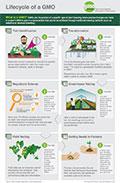Question
what are some problems with trying to genetically engineer trees
Submitted by: boatman1
Answer
Expert response from William Powell
Professor and Director, Counsel on Biotechnology in Forestry, State University of New York College of Environmental Science and Forestry
Monday, 06/07/2015 21:42
First, there are many benefits to using genetic engineering tools compared to breeding tools, mainly from the fact that we are making much smaller changes to the tree and we know more about these changes. But you asked about problems. The first problem is developing an efficient transformation technique. Each tree species is different and requires optimization of techniques. It took 16 years to develop the techniques for American chestnut, but now that we have them in hand, we can genetically engineer a tree in less than a year, far quicker than breeding. So when you start working on a new tree you will face these initial challenges.
Another problem, and probably the biggest, is the U.S. has a regulatory system that was not designed to efficiently evaluate transgenic trees. It was originally designed to regulate chemicals and was adapted to review transgenic plants, which of course are very different. All genetically engineered trees are highly regulated by the EPA, USDA, and if a food product is involved, the FDA. But if the same traits in the tree were produced by hybrid breeding, radiation or chemical mutation, cell fusions, or tissue culture somaclonal variation, they would not be regulated. This is uneven treatment is a problem because it adds several years and millions of dollars to development of genetically engineered trees. But the good part is that more is known about genetically engineered trees than any produced by traditional methods.
Answer
Expert response from William Powell
Professor and Director, Counsel on Biotechnology in Forestry, State University of New York College of Environmental Science and Forestry
Monday, 06/07/2015 21:42
First, there are many benefits to using genetic engineering tools compared to breeding tools, mainly from the fact that we are making much smaller changes to the tree and we know more about these changes. But you asked about problems. The first problem is developing an efficient transformation technique. Each tree species is different and requires optimization of techniques. It took 16 years to develop the techniques for American chestnut, but now that we have them in hand, we can genetically engineer a tree in less than a year, far quicker than breeding. So when you start working on a new tree you will face these initial challenges.
Another problem, and probably the biggest, is the U.S. has a regulatory system that was not designed to efficiently evaluate transgenic trees. It was originally designed to regulate chemicals and was adapted to review transgenic plants, which of course are very different. All genetically engineered trees are highly regulated by the EPA, USDA, and if a food product is involved, the FDA. But if the same traits in the tree were produced by hybrid breeding, radiation or chemical mutation, cell fusions, or tissue culture somaclonal variation, they would not be regulated. This is uneven treatment is a problem because it adds several years and millions of dollars to development of genetically engineered trees. But the good part is that more is known about genetically engineered trees than any produced by traditional methods.
GMO Innovation Contest Recap!
